Theories and Physiology of Ageing in Residential Aged Care Facilities
VerifiedAdded on 2023/06/09
|7
|2217
|458
Literature Review
AI Summary
This literature review delves into the theories and physiology of ageing, focusing on residential aged care facilities. It explores biological theories, including programmed and damage/error theories, and psychosocial theories like disengagement, continuity, and activity theories. The review also examines the wear and tear theory and the social exchange theory of ageing. Furthermore, it discusses physiological changes in various organs, such as the heart, lungs, skin, and muscles, and their impact on the ageing process. The review emphasizes the importance of considering these factors in providing optimal care services to older adults in residential facilities, promoting healthy ageing and maintaining their quality of life. It concludes that ageing is not necessarily a problem and older adults can still contribute to society.
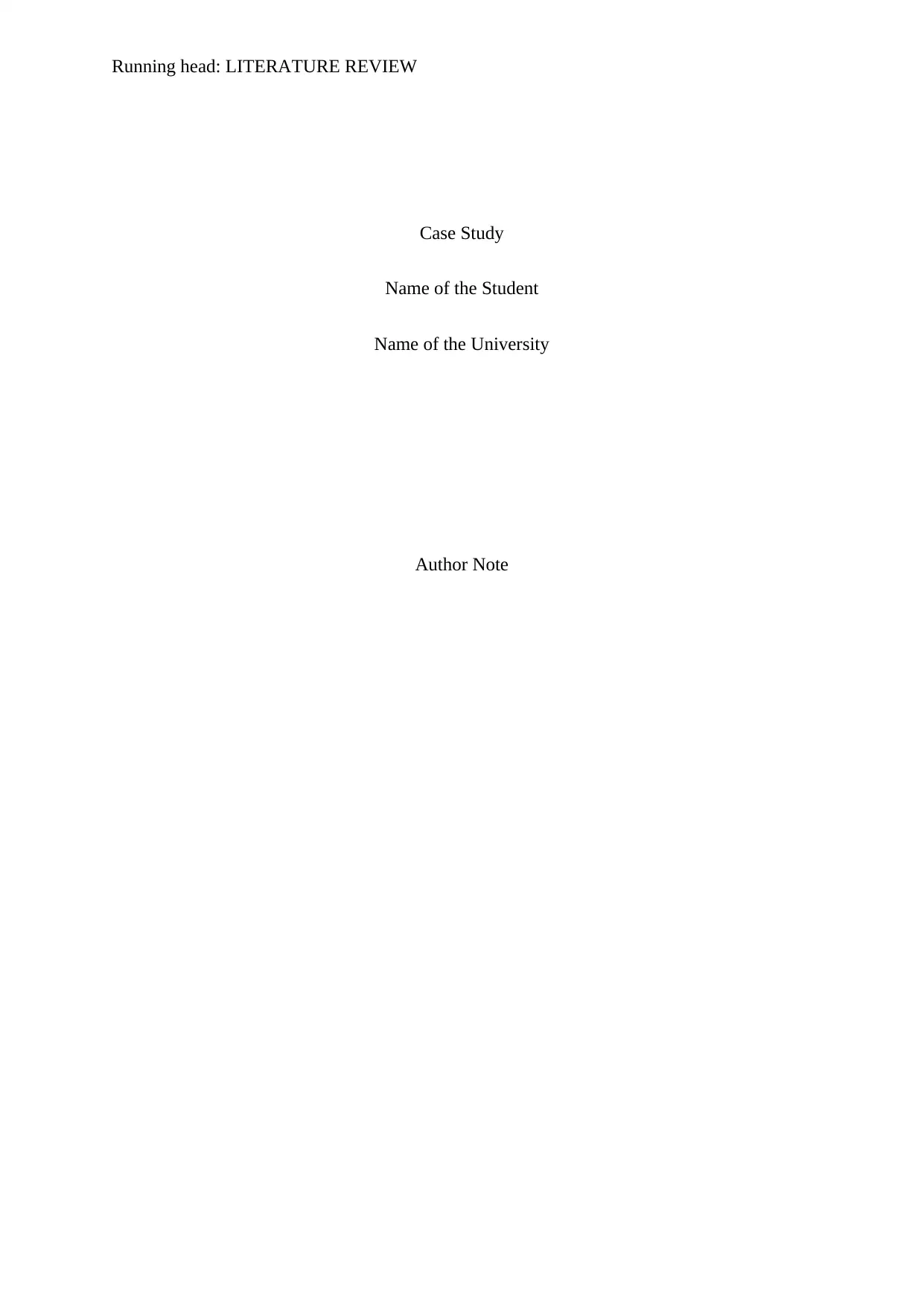
Running head: LITERATURE REVIEW
Case Study
Name of the Student
Name of the University
Author Note
Case Study
Name of the Student
Name of the University
Author Note
Paraphrase This Document
Need a fresh take? Get an instant paraphrase of this document with our AI Paraphraser
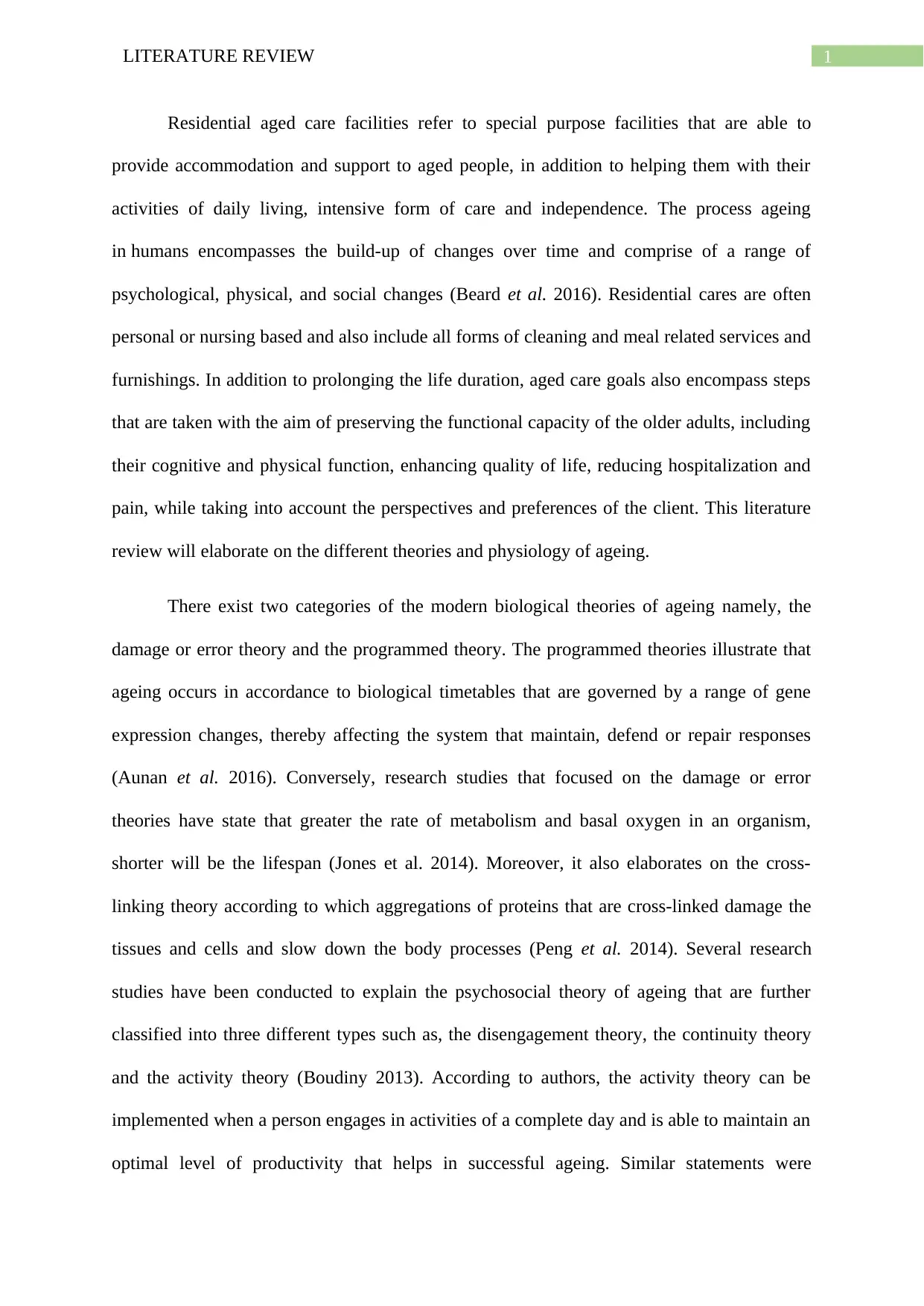
1LITERATURE REVIEW
Residential aged care facilities refer to special purpose facilities that are able to
provide accommodation and support to aged people, in addition to helping them with their
activities of daily living, intensive form of care and independence. The process ageing
in humans encompasses the build-up of changes over time and comprise of a range of
psychological, physical, and social changes (Beard et al. 2016). Residential cares are often
personal or nursing based and also include all forms of cleaning and meal related services and
furnishings. In addition to prolonging the life duration, aged care goals also encompass steps
that are taken with the aim of preserving the functional capacity of the older adults, including
their cognitive and physical function, enhancing quality of life, reducing hospitalization and
pain, while taking into account the perspectives and preferences of the client. This literature
review will elaborate on the different theories and physiology of ageing.
There exist two categories of the modern biological theories of ageing namely, the
damage or error theory and the programmed theory. The programmed theories illustrate that
ageing occurs in accordance to biological timetables that are governed by a range of gene
expression changes, thereby affecting the system that maintain, defend or repair responses
(Aunan et al. 2016). Conversely, research studies that focused on the damage or error
theories have state that greater the rate of metabolism and basal oxygen in an organism,
shorter will be the lifespan (Jones et al. 2014). Moreover, it also elaborates on the cross-
linking theory according to which aggregations of proteins that are cross-linked damage the
tissues and cells and slow down the body processes (Peng et al. 2014). Several research
studies have been conducted to explain the psychosocial theory of ageing that are further
classified into three different types such as, the disengagement theory, the continuity theory
and the activity theory (Boudiny 2013). According to authors, the activity theory can be
implemented when a person engages in activities of a complete day and is able to maintain an
optimal level of productivity that helps in successful ageing. Similar statements were
Residential aged care facilities refer to special purpose facilities that are able to
provide accommodation and support to aged people, in addition to helping them with their
activities of daily living, intensive form of care and independence. The process ageing
in humans encompasses the build-up of changes over time and comprise of a range of
psychological, physical, and social changes (Beard et al. 2016). Residential cares are often
personal or nursing based and also include all forms of cleaning and meal related services and
furnishings. In addition to prolonging the life duration, aged care goals also encompass steps
that are taken with the aim of preserving the functional capacity of the older adults, including
their cognitive and physical function, enhancing quality of life, reducing hospitalization and
pain, while taking into account the perspectives and preferences of the client. This literature
review will elaborate on the different theories and physiology of ageing.
There exist two categories of the modern biological theories of ageing namely, the
damage or error theory and the programmed theory. The programmed theories illustrate that
ageing occurs in accordance to biological timetables that are governed by a range of gene
expression changes, thereby affecting the system that maintain, defend or repair responses
(Aunan et al. 2016). Conversely, research studies that focused on the damage or error
theories have state that greater the rate of metabolism and basal oxygen in an organism,
shorter will be the lifespan (Jones et al. 2014). Moreover, it also elaborates on the cross-
linking theory according to which aggregations of proteins that are cross-linked damage the
tissues and cells and slow down the body processes (Peng et al. 2014). Several research
studies have been conducted to explain the psychosocial theory of ageing that are further
classified into three different types such as, the disengagement theory, the continuity theory
and the activity theory (Boudiny 2013). According to authors, the activity theory can be
implemented when a person engages in activities of a complete day and is able to maintain an
optimal level of productivity that helps in successful ageing. Similar statements were
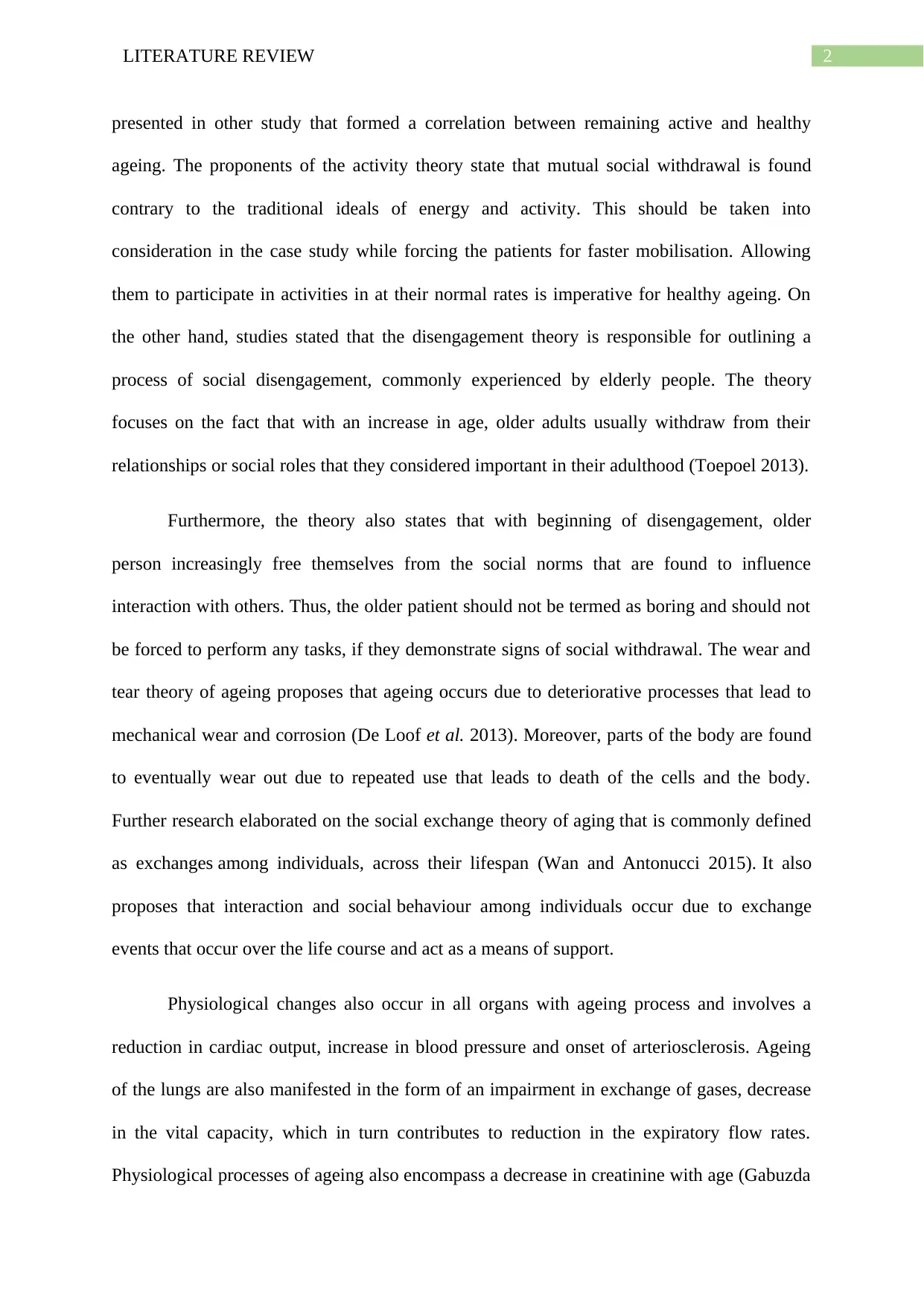
2LITERATURE REVIEW
presented in other study that formed a correlation between remaining active and healthy
ageing. The proponents of the activity theory state that mutual social withdrawal is found
contrary to the traditional ideals of energy and activity. This should be taken into
consideration in the case study while forcing the patients for faster mobilisation. Allowing
them to participate in activities in at their normal rates is imperative for healthy ageing. On
the other hand, studies stated that the disengagement theory is responsible for outlining a
process of social disengagement, commonly experienced by elderly people. The theory
focuses on the fact that with an increase in age, older adults usually withdraw from their
relationships or social roles that they considered important in their adulthood (Toepoel 2013).
Furthermore, the theory also states that with beginning of disengagement, older
person increasingly free themselves from the social norms that are found to influence
interaction with others. Thus, the older patient should not be termed as boring and should not
be forced to perform any tasks, if they demonstrate signs of social withdrawal. The wear and
tear theory of ageing proposes that ageing occurs due to deteriorative processes that lead to
mechanical wear and corrosion (De Loof et al. 2013). Moreover, parts of the body are found
to eventually wear out due to repeated use that leads to death of the cells and the body.
Further research elaborated on the social exchange theory of aging that is commonly defined
as exchanges among individuals, across their lifespan (Wan and Antonucci 2015). It also
proposes that interaction and social behaviour among individuals occur due to exchange
events that occur over the life course and act as a means of support.
Physiological changes also occur in all organs with ageing process and involves a
reduction in cardiac output, increase in blood pressure and onset of arteriosclerosis. Ageing
of the lungs are also manifested in the form of an impairment in exchange of gases, decrease
in the vital capacity, which in turn contributes to reduction in the expiratory flow rates.
Physiological processes of ageing also encompass a decrease in creatinine with age (Gabuzda
presented in other study that formed a correlation between remaining active and healthy
ageing. The proponents of the activity theory state that mutual social withdrawal is found
contrary to the traditional ideals of energy and activity. This should be taken into
consideration in the case study while forcing the patients for faster mobilisation. Allowing
them to participate in activities in at their normal rates is imperative for healthy ageing. On
the other hand, studies stated that the disengagement theory is responsible for outlining a
process of social disengagement, commonly experienced by elderly people. The theory
focuses on the fact that with an increase in age, older adults usually withdraw from their
relationships or social roles that they considered important in their adulthood (Toepoel 2013).
Furthermore, the theory also states that with beginning of disengagement, older
person increasingly free themselves from the social norms that are found to influence
interaction with others. Thus, the older patient should not be termed as boring and should not
be forced to perform any tasks, if they demonstrate signs of social withdrawal. The wear and
tear theory of ageing proposes that ageing occurs due to deteriorative processes that lead to
mechanical wear and corrosion (De Loof et al. 2013). Moreover, parts of the body are found
to eventually wear out due to repeated use that leads to death of the cells and the body.
Further research elaborated on the social exchange theory of aging that is commonly defined
as exchanges among individuals, across their lifespan (Wan and Antonucci 2015). It also
proposes that interaction and social behaviour among individuals occur due to exchange
events that occur over the life course and act as a means of support.
Physiological changes also occur in all organs with ageing process and involves a
reduction in cardiac output, increase in blood pressure and onset of arteriosclerosis. Ageing
of the lungs are also manifested in the form of an impairment in exchange of gases, decrease
in the vital capacity, which in turn contributes to reduction in the expiratory flow rates.
Physiological processes of ageing also encompass a decrease in creatinine with age (Gabuzda
⊘ This is a preview!⊘
Do you want full access?
Subscribe today to unlock all pages.

Trusted by 1+ million students worldwide
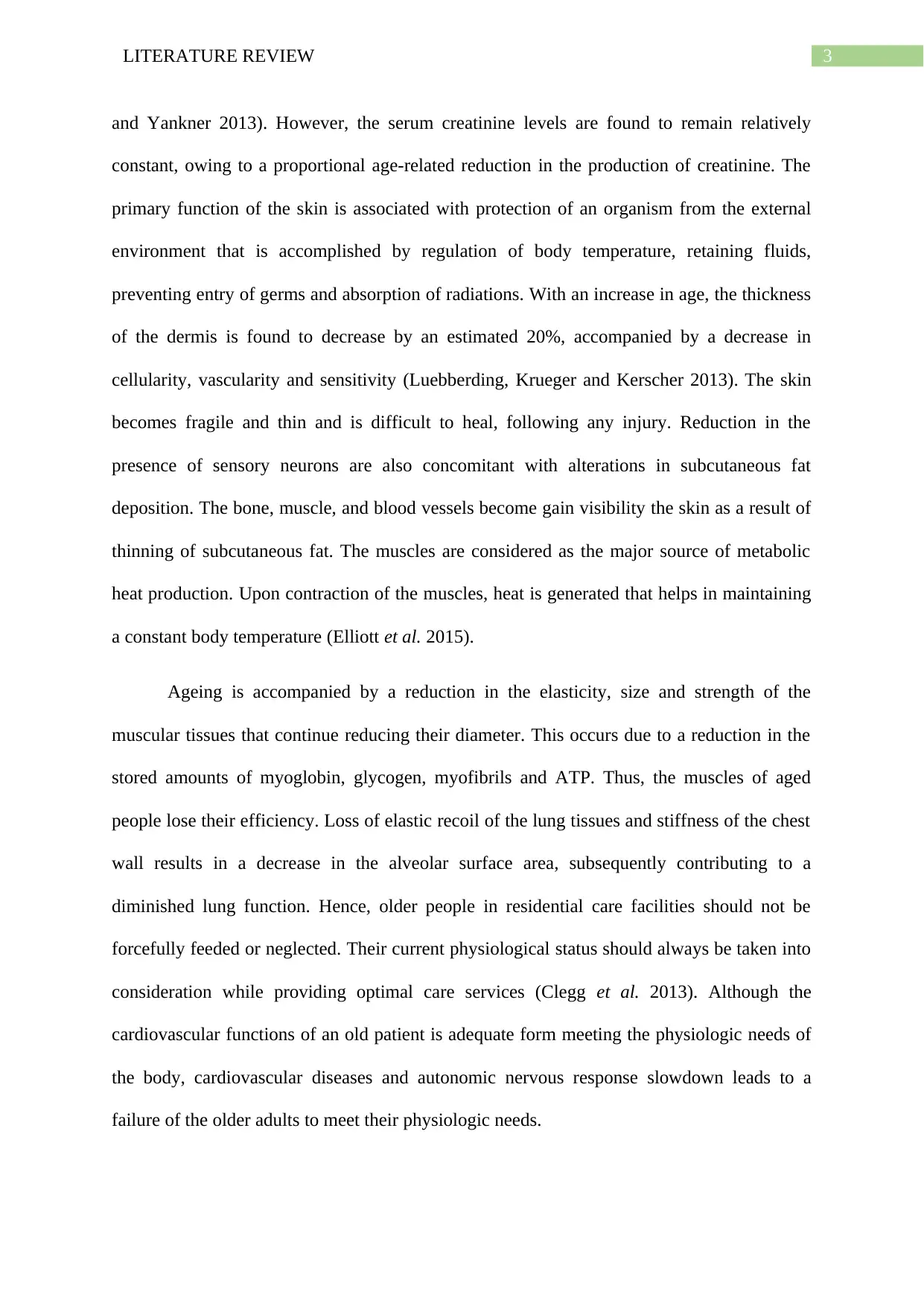
3LITERATURE REVIEW
and Yankner 2013). However, the serum creatinine levels are found to remain relatively
constant, owing to a proportional age-related reduction in the production of creatinine. The
primary function of the skin is associated with protection of an organism from the external
environment that is accomplished by regulation of body temperature, retaining fluids,
preventing entry of germs and absorption of radiations. With an increase in age, the thickness
of the dermis is found to decrease by an estimated 20%, accompanied by a decrease in
cellularity, vascularity and sensitivity (Luebberding, Krueger and Kerscher 2013). The skin
becomes fragile and thin and is difficult to heal, following any injury. Reduction in the
presence of sensory neurons are also concomitant with alterations in subcutaneous fat
deposition. The bone, muscle, and blood vessels become gain visibility the skin as a result of
thinning of subcutaneous fat. The muscles are considered as the major source of metabolic
heat production. Upon contraction of the muscles, heat is generated that helps in maintaining
a constant body temperature (Elliott et al. 2015).
Ageing is accompanied by a reduction in the elasticity, size and strength of the
muscular tissues that continue reducing their diameter. This occurs due to a reduction in the
stored amounts of myoglobin, glycogen, myofibrils and ATP. Thus, the muscles of aged
people lose their efficiency. Loss of elastic recoil of the lung tissues and stiffness of the chest
wall results in a decrease in the alveolar surface area, subsequently contributing to a
diminished lung function. Hence, older people in residential care facilities should not be
forcefully feeded or neglected. Their current physiological status should always be taken into
consideration while providing optimal care services (Clegg et al. 2013). Although the
cardiovascular functions of an old patient is adequate form meeting the physiologic needs of
the body, cardiovascular diseases and autonomic nervous response slowdown leads to a
failure of the older adults to meet their physiologic needs.
and Yankner 2013). However, the serum creatinine levels are found to remain relatively
constant, owing to a proportional age-related reduction in the production of creatinine. The
primary function of the skin is associated with protection of an organism from the external
environment that is accomplished by regulation of body temperature, retaining fluids,
preventing entry of germs and absorption of radiations. With an increase in age, the thickness
of the dermis is found to decrease by an estimated 20%, accompanied by a decrease in
cellularity, vascularity and sensitivity (Luebberding, Krueger and Kerscher 2013). The skin
becomes fragile and thin and is difficult to heal, following any injury. Reduction in the
presence of sensory neurons are also concomitant with alterations in subcutaneous fat
deposition. The bone, muscle, and blood vessels become gain visibility the skin as a result of
thinning of subcutaneous fat. The muscles are considered as the major source of metabolic
heat production. Upon contraction of the muscles, heat is generated that helps in maintaining
a constant body temperature (Elliott et al. 2015).
Ageing is accompanied by a reduction in the elasticity, size and strength of the
muscular tissues that continue reducing their diameter. This occurs due to a reduction in the
stored amounts of myoglobin, glycogen, myofibrils and ATP. Thus, the muscles of aged
people lose their efficiency. Loss of elastic recoil of the lung tissues and stiffness of the chest
wall results in a decrease in the alveolar surface area, subsequently contributing to a
diminished lung function. Hence, older people in residential care facilities should not be
forcefully feeded or neglected. Their current physiological status should always be taken into
consideration while providing optimal care services (Clegg et al. 2013). Although the
cardiovascular functions of an old patient is adequate form meeting the physiologic needs of
the body, cardiovascular diseases and autonomic nervous response slowdown leads to a
failure of the older adults to meet their physiologic needs.
Paraphrase This Document
Need a fresh take? Get an instant paraphrase of this document with our AI Paraphraser
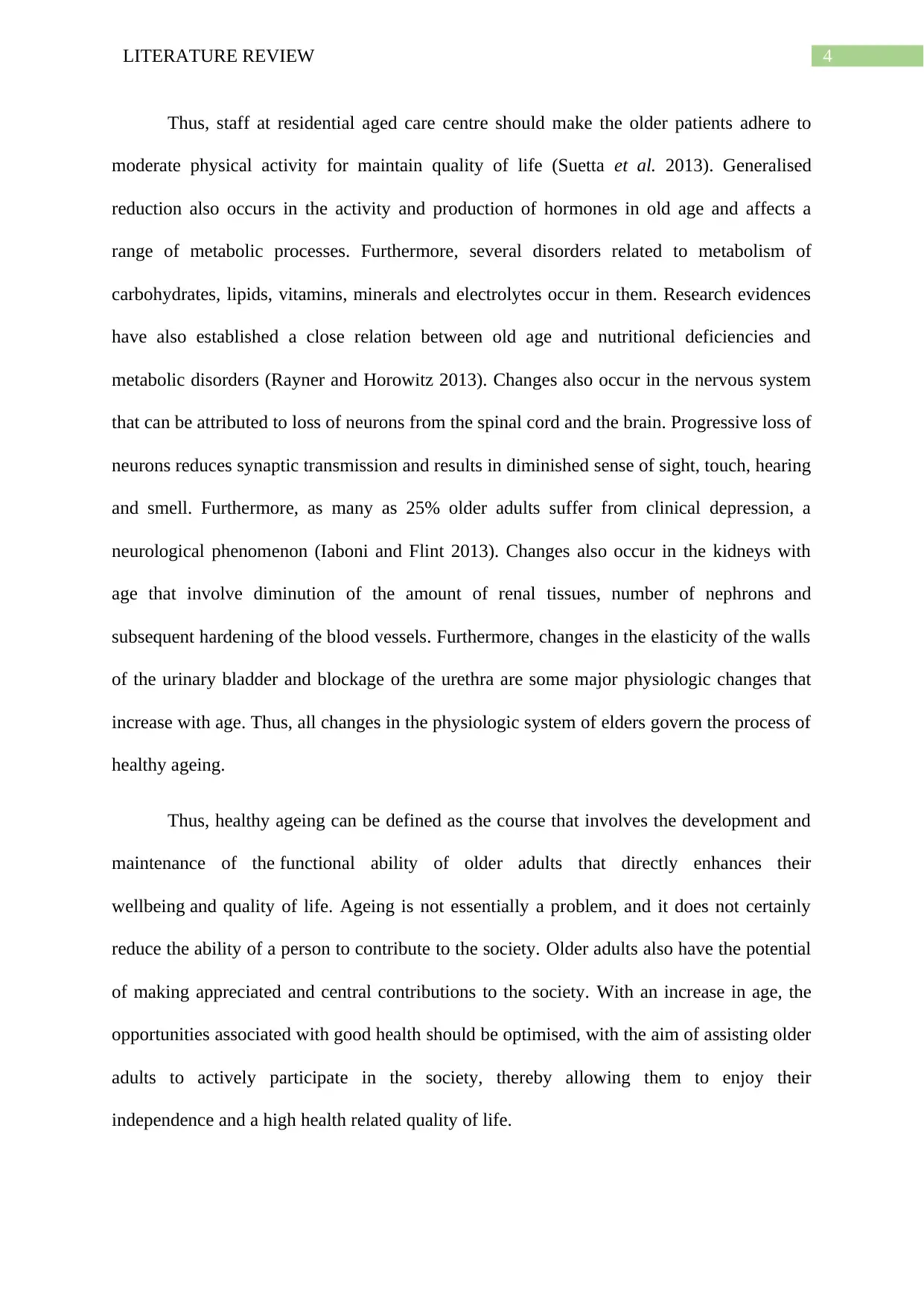
4LITERATURE REVIEW
Thus, staff at residential aged care centre should make the older patients adhere to
moderate physical activity for maintain quality of life (Suetta et al. 2013). Generalised
reduction also occurs in the activity and production of hormones in old age and affects a
range of metabolic processes. Furthermore, several disorders related to metabolism of
carbohydrates, lipids, vitamins, minerals and electrolytes occur in them. Research evidences
have also established a close relation between old age and nutritional deficiencies and
metabolic disorders (Rayner and Horowitz 2013). Changes also occur in the nervous system
that can be attributed to loss of neurons from the spinal cord and the brain. Progressive loss of
neurons reduces synaptic transmission and results in diminished sense of sight, touch, hearing
and smell. Furthermore, as many as 25% older adults suffer from clinical depression, a
neurological phenomenon (Iaboni and Flint 2013). Changes also occur in the kidneys with
age that involve diminution of the amount of renal tissues, number of nephrons and
subsequent hardening of the blood vessels. Furthermore, changes in the elasticity of the walls
of the urinary bladder and blockage of the urethra are some major physiologic changes that
increase with age. Thus, all changes in the physiologic system of elders govern the process of
healthy ageing.
Thus, healthy ageing can be defined as the course that involves the development and
maintenance of the functional ability of older adults that directly enhances their
wellbeing and quality of life. Ageing is not essentially a problem, and it does not certainly
reduce the ability of a person to contribute to the society. Older adults also have the potential
of making appreciated and central contributions to the society. With an increase in age, the
opportunities associated with good health should be optimised, with the aim of assisting older
adults to actively participate in the society, thereby allowing them to enjoy their
independence and a high health related quality of life.
Thus, staff at residential aged care centre should make the older patients adhere to
moderate physical activity for maintain quality of life (Suetta et al. 2013). Generalised
reduction also occurs in the activity and production of hormones in old age and affects a
range of metabolic processes. Furthermore, several disorders related to metabolism of
carbohydrates, lipids, vitamins, minerals and electrolytes occur in them. Research evidences
have also established a close relation between old age and nutritional deficiencies and
metabolic disorders (Rayner and Horowitz 2013). Changes also occur in the nervous system
that can be attributed to loss of neurons from the spinal cord and the brain. Progressive loss of
neurons reduces synaptic transmission and results in diminished sense of sight, touch, hearing
and smell. Furthermore, as many as 25% older adults suffer from clinical depression, a
neurological phenomenon (Iaboni and Flint 2013). Changes also occur in the kidneys with
age that involve diminution of the amount of renal tissues, number of nephrons and
subsequent hardening of the blood vessels. Furthermore, changes in the elasticity of the walls
of the urinary bladder and blockage of the urethra are some major physiologic changes that
increase with age. Thus, all changes in the physiologic system of elders govern the process of
healthy ageing.
Thus, healthy ageing can be defined as the course that involves the development and
maintenance of the functional ability of older adults that directly enhances their
wellbeing and quality of life. Ageing is not essentially a problem, and it does not certainly
reduce the ability of a person to contribute to the society. Older adults also have the potential
of making appreciated and central contributions to the society. With an increase in age, the
opportunities associated with good health should be optimised, with the aim of assisting older
adults to actively participate in the society, thereby allowing them to enjoy their
independence and a high health related quality of life.
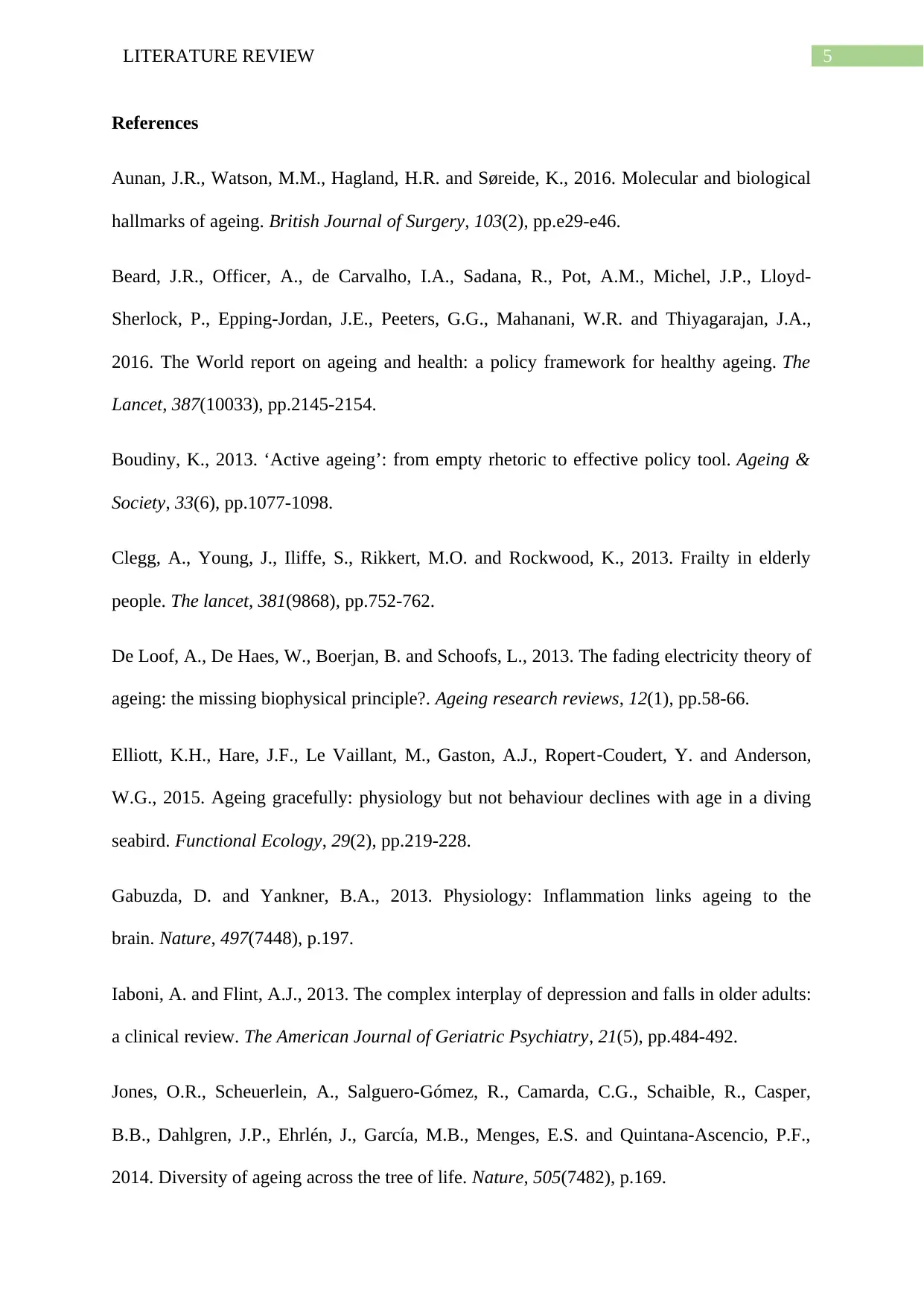
5LITERATURE REVIEW
References
Aunan, J.R., Watson, M.M., Hagland, H.R. and Søreide, K., 2016. Molecular and biological
hallmarks of ageing. British Journal of Surgery, 103(2), pp.e29-e46.
Beard, J.R., Officer, A., de Carvalho, I.A., Sadana, R., Pot, A.M., Michel, J.P., Lloyd-
Sherlock, P., Epping-Jordan, J.E., Peeters, G.G., Mahanani, W.R. and Thiyagarajan, J.A.,
2016. The World report on ageing and health: a policy framework for healthy ageing. The
Lancet, 387(10033), pp.2145-2154.
Boudiny, K., 2013. ‘Active ageing’: from empty rhetoric to effective policy tool. Ageing &
Society, 33(6), pp.1077-1098.
Clegg, A., Young, J., Iliffe, S., Rikkert, M.O. and Rockwood, K., 2013. Frailty in elderly
people. The lancet, 381(9868), pp.752-762.
De Loof, A., De Haes, W., Boerjan, B. and Schoofs, L., 2013. The fading electricity theory of
ageing: the missing biophysical principle?. Ageing research reviews, 12(1), pp.58-66.
Elliott, K.H., Hare, J.F., Le Vaillant, M., Gaston, A.J., Ropert‐Coudert, Y. and Anderson,
W.G., 2015. Ageing gracefully: physiology but not behaviour declines with age in a diving
seabird. Functional Ecology, 29(2), pp.219-228.
Gabuzda, D. and Yankner, B.A., 2013. Physiology: Inflammation links ageing to the
brain. Nature, 497(7448), p.197.
Iaboni, A. and Flint, A.J., 2013. The complex interplay of depression and falls in older adults:
a clinical review. The American Journal of Geriatric Psychiatry, 21(5), pp.484-492.
Jones, O.R., Scheuerlein, A., Salguero-Gómez, R., Camarda, C.G., Schaible, R., Casper,
B.B., Dahlgren, J.P., Ehrlén, J., García, M.B., Menges, E.S. and Quintana-Ascencio, P.F.,
2014. Diversity of ageing across the tree of life. Nature, 505(7482), p.169.
References
Aunan, J.R., Watson, M.M., Hagland, H.R. and Søreide, K., 2016. Molecular and biological
hallmarks of ageing. British Journal of Surgery, 103(2), pp.e29-e46.
Beard, J.R., Officer, A., de Carvalho, I.A., Sadana, R., Pot, A.M., Michel, J.P., Lloyd-
Sherlock, P., Epping-Jordan, J.E., Peeters, G.G., Mahanani, W.R. and Thiyagarajan, J.A.,
2016. The World report on ageing and health: a policy framework for healthy ageing. The
Lancet, 387(10033), pp.2145-2154.
Boudiny, K., 2013. ‘Active ageing’: from empty rhetoric to effective policy tool. Ageing &
Society, 33(6), pp.1077-1098.
Clegg, A., Young, J., Iliffe, S., Rikkert, M.O. and Rockwood, K., 2013. Frailty in elderly
people. The lancet, 381(9868), pp.752-762.
De Loof, A., De Haes, W., Boerjan, B. and Schoofs, L., 2013. The fading electricity theory of
ageing: the missing biophysical principle?. Ageing research reviews, 12(1), pp.58-66.
Elliott, K.H., Hare, J.F., Le Vaillant, M., Gaston, A.J., Ropert‐Coudert, Y. and Anderson,
W.G., 2015. Ageing gracefully: physiology but not behaviour declines with age in a diving
seabird. Functional Ecology, 29(2), pp.219-228.
Gabuzda, D. and Yankner, B.A., 2013. Physiology: Inflammation links ageing to the
brain. Nature, 497(7448), p.197.
Iaboni, A. and Flint, A.J., 2013. The complex interplay of depression and falls in older adults:
a clinical review. The American Journal of Geriatric Psychiatry, 21(5), pp.484-492.
Jones, O.R., Scheuerlein, A., Salguero-Gómez, R., Camarda, C.G., Schaible, R., Casper,
B.B., Dahlgren, J.P., Ehrlén, J., García, M.B., Menges, E.S. and Quintana-Ascencio, P.F.,
2014. Diversity of ageing across the tree of life. Nature, 505(7482), p.169.
⊘ This is a preview!⊘
Do you want full access?
Subscribe today to unlock all pages.

Trusted by 1+ million students worldwide
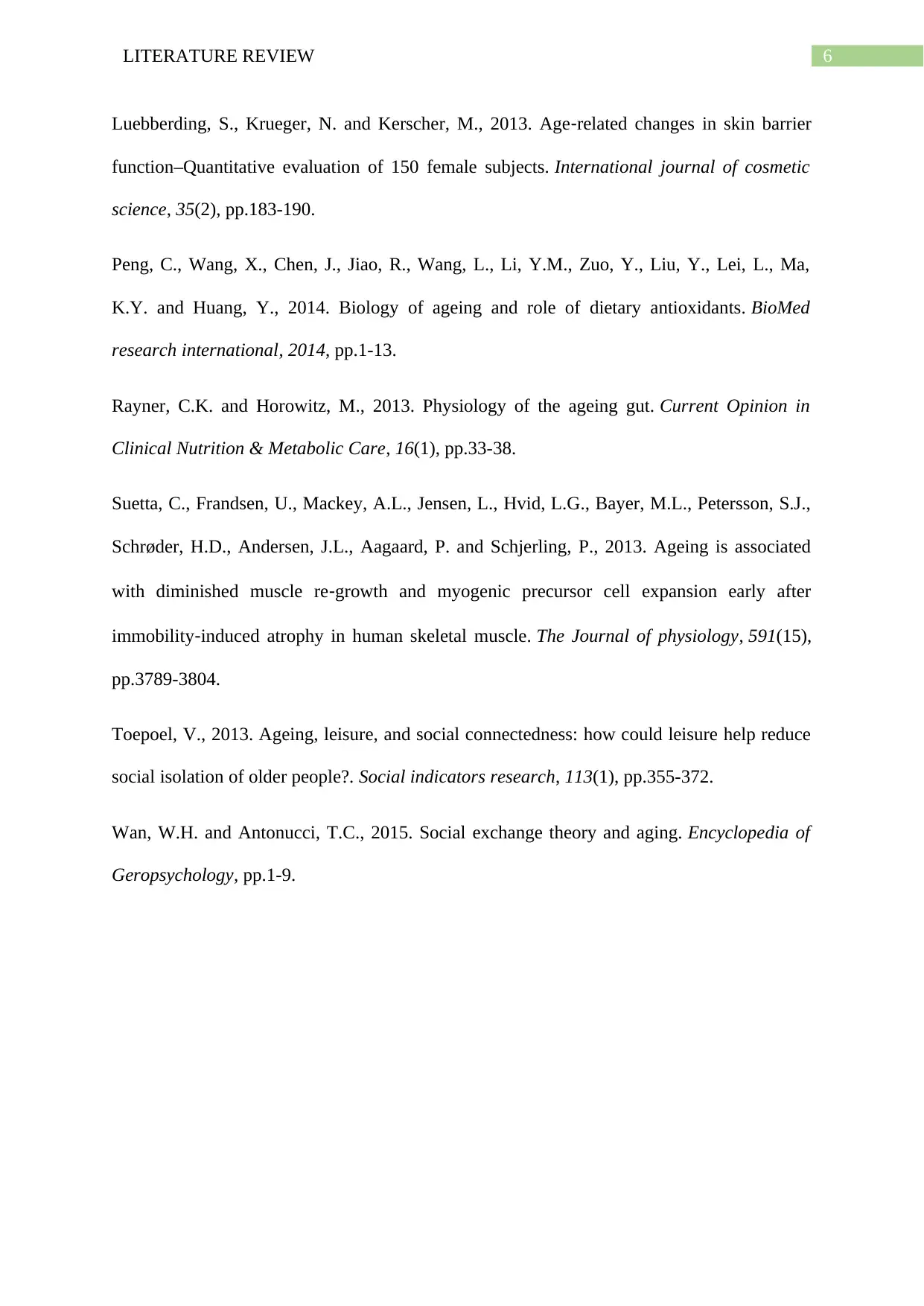
6LITERATURE REVIEW
Luebberding, S., Krueger, N. and Kerscher, M., 2013. Age‐related changes in skin barrier
function–Quantitative evaluation of 150 female subjects. International journal of cosmetic
science, 35(2), pp.183-190.
Peng, C., Wang, X., Chen, J., Jiao, R., Wang, L., Li, Y.M., Zuo, Y., Liu, Y., Lei, L., Ma,
K.Y. and Huang, Y., 2014. Biology of ageing and role of dietary antioxidants. BioMed
research international, 2014, pp.1-13.
Rayner, C.K. and Horowitz, M., 2013. Physiology of the ageing gut. Current Opinion in
Clinical Nutrition & Metabolic Care, 16(1), pp.33-38.
Suetta, C., Frandsen, U., Mackey, A.L., Jensen, L., Hvid, L.G., Bayer, M.L., Petersson, S.J.,
Schrøder, H.D., Andersen, J.L., Aagaard, P. and Schjerling, P., 2013. Ageing is associated
with diminished muscle re‐growth and myogenic precursor cell expansion early after
immobility‐induced atrophy in human skeletal muscle. The Journal of physiology, 591(15),
pp.3789-3804.
Toepoel, V., 2013. Ageing, leisure, and social connectedness: how could leisure help reduce
social isolation of older people?. Social indicators research, 113(1), pp.355-372.
Wan, W.H. and Antonucci, T.C., 2015. Social exchange theory and aging. Encyclopedia of
Geropsychology, pp.1-9.
Luebberding, S., Krueger, N. and Kerscher, M., 2013. Age‐related changes in skin barrier
function–Quantitative evaluation of 150 female subjects. International journal of cosmetic
science, 35(2), pp.183-190.
Peng, C., Wang, X., Chen, J., Jiao, R., Wang, L., Li, Y.M., Zuo, Y., Liu, Y., Lei, L., Ma,
K.Y. and Huang, Y., 2014. Biology of ageing and role of dietary antioxidants. BioMed
research international, 2014, pp.1-13.
Rayner, C.K. and Horowitz, M., 2013. Physiology of the ageing gut. Current Opinion in
Clinical Nutrition & Metabolic Care, 16(1), pp.33-38.
Suetta, C., Frandsen, U., Mackey, A.L., Jensen, L., Hvid, L.G., Bayer, M.L., Petersson, S.J.,
Schrøder, H.D., Andersen, J.L., Aagaard, P. and Schjerling, P., 2013. Ageing is associated
with diminished muscle re‐growth and myogenic precursor cell expansion early after
immobility‐induced atrophy in human skeletal muscle. The Journal of physiology, 591(15),
pp.3789-3804.
Toepoel, V., 2013. Ageing, leisure, and social connectedness: how could leisure help reduce
social isolation of older people?. Social indicators research, 113(1), pp.355-372.
Wan, W.H. and Antonucci, T.C., 2015. Social exchange theory and aging. Encyclopedia of
Geropsychology, pp.1-9.
1 out of 7
Related Documents
Your All-in-One AI-Powered Toolkit for Academic Success.
+13062052269
info@desklib.com
Available 24*7 on WhatsApp / Email
![[object Object]](/_next/static/media/star-bottom.7253800d.svg)
Unlock your academic potential
Copyright © 2020–2025 A2Z Services. All Rights Reserved. Developed and managed by ZUCOL.





